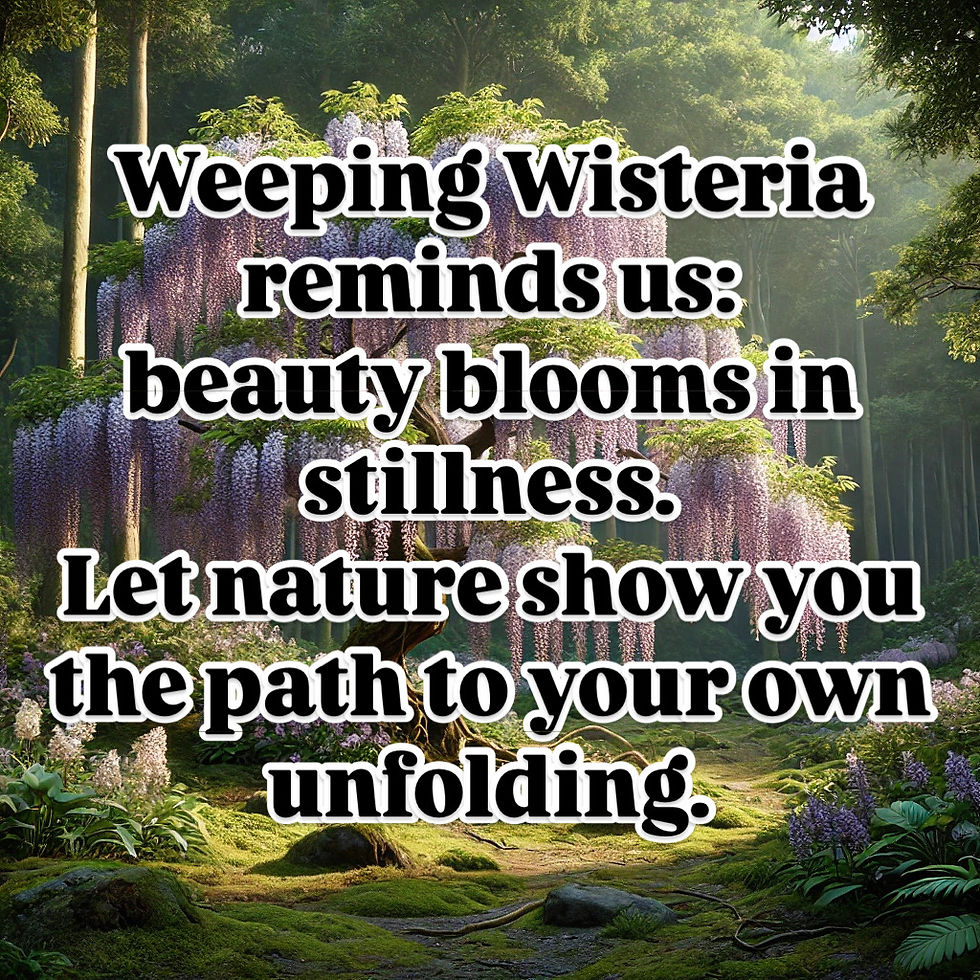The Wisdom of Weeping Wisteria: Graceful Growth & Plant Spirit Connection
- Leslie Wilson
- Apr 10
- 4 min read
Wisteria doesn’t bloom in a rush. She unfurls herself slowly—falling, draping, and cascading with a beauty that seems to defy gravity. Her presence is quiet, but her message is profound: To grow upward, we must first allow ourselves to fall.
In a world that constantly urges us to climb, achieve, and rise, Wisteria reminds us that true growth begins with surrender. Her blooms descend toward the earth, softening into stillness before ever reaching toward the sun. This sacred plant spirit shows us how to let go, how to root deeper, and how to grow from grace—not force.
The Physical Nature of Wisteria
Wisteria is a deciduous climbing vine known for its stunning, pendulous blooms in shades of purple, lavender, white, and pink. Found throughout North Carolina and many temperate regions, she transforms arbors, fences, and porches into otherworldly sanctuaries.
While Wisteria is visually enchanting, it’s important to note that the plant is toxic if ingested. For this reason, her medicine is best received energetically, spiritually, and through respectful connection—rather than physical use in teas or tinctures. She doesn’t need to be picked to be powerful.
Planting Wisteria requires patience. She can take years to bloom, but when she does, her presence is breathtaking—reminding us that beauty cultivated over time is worth the wait.
Metaphysical & Spiritual Benefits of Wisteria
Wisteria carries a deeply feminine, almost ancestral energy. She connects to both the heart chakra—through her emotional softness—and the crown chakra, offering access to spiritual insight and divine communication.
Her symbolism includes:
• Surrender – letting go of control and trusting divine timing.
• Rebirth – her spring blooms follow a period of winter stillness, just like spiritual awakening after inner healing.
• Graceful strength – teaching us that vulnerability and softness are forms of true resilience.
• Connection to past lives and soul memory – helping us retrieve parts of ourselves left behind or buried beneath fear.
She shows us that growth is not linear. It spirals. It curves. It falls before it rises.
Wisteria teaches us to descend inward—into our own hearts, into our shadows, into the silence—before we can bloom into our full spiritual radiance.
Wisteria & the Spirit Realm
Some plants act as bridges between worlds, and Wisteria is one of them. When you sit beneath her blossoms or attune to her energy, you may feel time soften, the veil thin, and your intuition heighten.
She’s an ally for:
• Spirit communication and mediumship
• Connecting to ancestral energy
• Dreamwork and intuitive downloads
• Meditation, breathwork, and chakra balancing
Wisteria’s energy moves like a flowing waterfall—clearing, guiding, and soothing the energetic field. She creates a sense of peace that allows the divine to enter without fear or force.
How to Work with Wisteria Respectfully
You do not need to cut her to connect with her. In fact, Wisteria often prefers to be admired, acknowledged, and loved in her natural form.
Here are gentle ways to build a relationship with Wisteria:
• Sit near a blooming vine or place a photo on your altar. Let her become a presence in your sacred space.
• Send her Reiki or gratitude as an offering. Plants, especially sensitive ones like Wisteria, feel our energy.
• Write letters to her as you would to a guide or mentor. Ask her to share her wisdom with you.
• Create a ritual of surrender. Sit beneath her or envision her in meditation. Breathe, soften, and allow yourself to fall into trust—just as her blossoms do.
If you do find fallen petals on the ground, you may collect them gently with thanks. Press them into a journal, use them on your altar, or place them in a bowl of water to infuse your space with her spirit.
Suggested Meditation:
“The Descent Before the Bloom”
Find a quiet space where you can sit comfortably or lie down. If you have a photo of Wisteria or a view of the vine, gaze softly upon it.
Close your eyes.
Breathe deeply into your belly.
With each exhale, imagine the tension falling from your body like Wisteria blooms—soft, light, slow.
Repeat silently:
“I allow myself to fall into trust. I surrender what I no longer need. I welcome the wisdom in stillness.”
Feel yourself sinking—not into despair, but into the safety of being held. Imagine Wisteria’s blossoms forming a canopy above you, gently draping you in violet light. Let yourself be cocooned. Rest here as long as you need.
When you feel ready, slowly bring your awareness back, placing your hands on your heart.
Journaling Prompt: The Spiral Path of Growth
Wisteria teaches us that falling isn’t failing—it’s part of the sacred cycle. What am I currently being asked to release in order to grow? Where in my life am I being called to soften, trust, or surrender more deeply?
Write freely. Let her voice come through your pen.
Wisteria reminds us that beauty doesn’t shout—it whispers. And it’s in that whisper that we are called home to ourselves. She teaches us to trust the descent, to bloom when we’re ready, and to honor the journey with grace.
So next time you pass by a Wisteria vine, pause. Listen. Breathe. There is magic blooming in the silence—and it just might be calling your name.




Comments